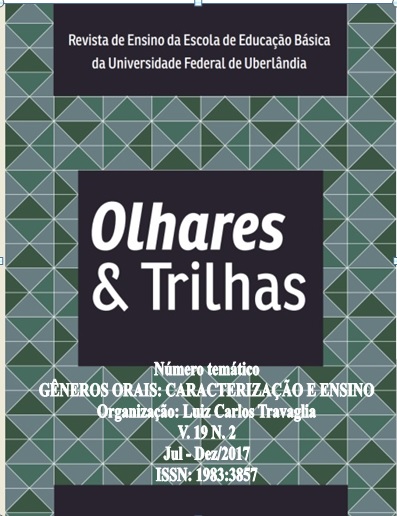CARACTERIZAÇÃO DO GÊNERO STAND UP
DOI:
https://doi.org/10.14393/OT2017v19.n.2.142-167Keywords:
Stand up, Oral genre, Critical Discourse Analysis (ADC)Abstract
The objective of this study is to conduct the critical discursive analysis of the stand-up genre samples based on the assumptions ofCritical Discourse Analysis (ADC). In order to develop the study, we selected four stand-up presentations taken from a corpus composed of twenty-eight (28) videos, published from 2011 to 2015, and posted on the internet by YouTube site. Through the empirical material, the transcribed text, we seek dialectical relations between discourse and social practices. Thus, we adopt Fairclough's (2003) proposal to analyze the ways in which discourse appears in social practices - ways of behaving, of representing and of being - articulated to the three meanings - the acting, representing and identifying. The genre in question was also analyzed in terms of activity, social relations and communication technologies. This study evidences potentialities of the ADC for the genres analysis and it constitutes an important contribution to this theoretical field and especially to the characterization of other oral genres.
Downloads
References
FAIRCLOUGH, Norman. Analysing discourse: textual analysis for social research.London: Routlege, 2003
FERREIRA, Aurélio Buarque de Holanda. Novo dicionário da língua portuguesa. 2.ed. Rio de Janeiro: Nova Fronteira, 1986. 183p.
GIL, Célia Maria Carcagnolo. A linguagem da surpresa: uma proposta para o estudo da piada. 1991, Tese (doutorado em Letras), FFLCH, Universidade de São Paulo, 1991.
LINS, Maria da Penha Pereira. Gramaticalização de agora. Disponível em: http://periodicos.ufes.br/contextoslinguisticos/article/view/5099. Acesso em: 20 jun. 2016.
MINOIS, Georges. História do riso e do escárnio. São Paulo: Editora UNESP, 2003.
PAPO de homem. Disponível em: http://papodehomem.com.br/comedia-stand-up-os-melhores-de-ontem-e-hoje/. Acesso em: 11 abr. 2016.
PORTAL do Stand upComedy. Disponível em: <http://www.portalstandupcomedy.com.br/historia/> Acesso em: 18 fev. 2013.
RASKIN, Victor. SemanticMechanisms of Humor. Proceedings of theFifthAnnnual Meeting of the Berkeley LinguisticsSociety, 1979, p. 325-335.
TRAVAGLIA, Luís Carlos. Texto humorístico: o tipo e seus gêneros. In: CARMELINO, A. C. (org.) Humor: eis a questão. São Paulo: Cortez, 2015, p. 49 – 90.
¬¬¬TRAVAGLIA, Luís Carlos. A caracterização de categorias de textos: tipos, gêneros e espécies. Alfa: Revista de Linguística, v. 51, p.39‐79, 2007a. Disponível em: < http://seer.fclar.unesp.br/alfa/article/viewFile/1426/1127>.
¬¬¬TRAVAGLIA, Luís Carlos..Um estudo textual-discursivo do verbo no Português do Brasil. 1991. 195 f. Tese (Doutorado em Linguística) – Instituto de Estudos da Linguagem, Universidade Estadual de Campinas, Campinas, 1991.

